|
||||||
|
LONICERA. Honeysuckles. [Caprifoliaceae] |
|
|
Eighteen species of Lonicera are recorded Lonicera. Elsewhere the tephritid Philophylla caesio is recorded as a miner in the petioles of Urtica sp. by Ferrar (1987), Beiger (1968) and White (1988), although there are unconfirmed records on Caprifoliaceae and Asteraceae, which seems an odd combination of hosts. A key to the European miners recorded on Lonicera is provided in Bladmineerders van Europa. |
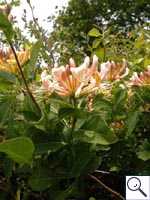 Honeysuckle Lonicera periclymenum |
Key for the identification of the known mines of British |
Note: Diptera larvae may live in a corridor mine, a corridor-blotch mine, or a blotch mine, but never in a case, a rolled or folded leaf, a tentiform mine or sandwiched between two more or less circular leaf sections in later instars. Pupation never in a cocoon. All mining Diptera larvae are leg-less maggots without a head capsule (see examples). They never have thoracic or abdominal legs. They do not have chewing mouthparts, although they do have a characteristic cephalo-pharyngeal skeleton (see examples), usually visible internally through the body wall. The larvae lie on their sides within the mine and use their pick-like mouthparts to feed on plant tissue. In some corridor miners frass may lie in two rows on alternate sides of the mine. In order to vacate the mine the fully grown larva cuts an exit slit, which is usually semi-circular (see Liriomyza huidobrensis video). The pupa is formed within the hardened last larval skin or puparium and as a result sheaths enclosing head appendages, wings and legs are not visible externally (see examples). See Key to non-Diptera. |
1a > Leaf-miner: Mine star shaped when small, sometimes with a longer linear section, later an irregular brownish blotch. Pupation internal (Spencer, 1976: 466). Mine not associated with the midrib, stellate, with a large number of short upper-surface corridors. The mine looks greyish and is inconspicuous. Frass in discrete grains. One, sometimes two larvae in a mine. Pupation within the mine. Forms an upper surface mine which is normally blotchy. The young mine is stellate. The initial mine is purple in colour - turning brown as it ages. |
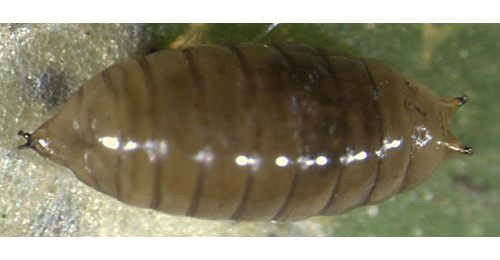 Chromatomyia periclymeni puparium Image: © Willem Ellis (Bladmineerders van Europa) |
|
Chromatomyia periclymeni (Meijere, 1924) [Diptera: Agromyzidae]. |
1b > Leaf-miner: Mine an irregular stellate blotch with a later linear section. Pupation internal; firmly glued within the mine by frass (Spencer, 1976: 443). The mine begins with a few lower-surface corridors, radiating from one centre that is not associated with the midrib; the corridors are very shallow and not easy to observe. Subsequently some (rarely only one) upper-surface, rather long and often branched corridors are formed from the same centre. Frass mostly at one side, in pearl chains. Pupation within the mine. An upper surface gallery with a star-shaped start. Frass in pearl-strings. |
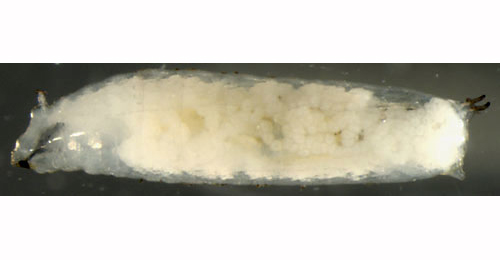 Chromatomyia lonicerae larva, lateral Image: © Willem Ellis (Bladmineerders van Europa) |
|
Chromatomyia lonicerae (Robineau-Desvoidy, 1851) [Diptera: Agromyzidae]. |
1c > Leaf-miner: The very first part of the mine is a quite inconspicuous, lower-surface epidermal corridor, that ends upon the midrib. Then the larva bores in the midrib, from where it makes long upper-surface corridors. Often the latest corridor that is made is much longer than the others, and follows the leaf outline in a loose loop. Frass in long strings at the extreme side of the mine. Pupation in the mine, in a lower-surface puparium chamber. Initially on the mid-rib from which there may be several short narrow galleries into the leaf. In the main gallery there may be alternate lower surface and upper surface stretches. Frass in conspicuous long streaks. A winter form not associated with the midrib and with a mine that meanders thoughout the leaf probably represents this species. Frass in long strings at the extreme side of the mine. Pupation in the mine, in a lower-surface puparium chamber |
|
Chromatomyia aprilina (Goureau, 1851) [Agromyzidae. |
1d > Leaf-miner: A long white mine. Pupation external (Spencer, 1972b: 62 (fig. 209), 65, as lonicerae). Strongly widening, upper-surface, unbranched corridor; its first section usually follows the leaf margin for some distance. Pupation outside the mine; exit slit in upper epidermis. Leaf mine is formed in the young tender leaf. Larva forming long white mine which widens. |
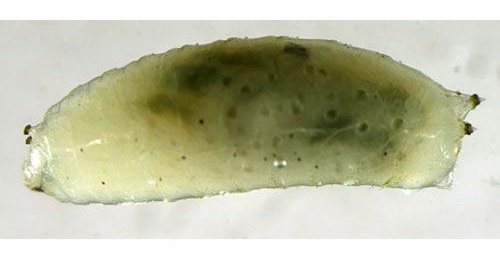 Aulagromyza cornigera larva, lateral Image: © Willem Ellis (Bladmineerders van Europa) |
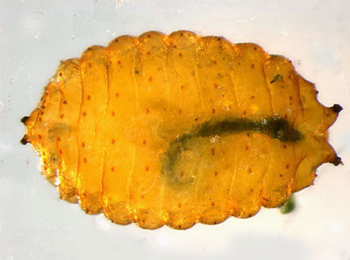 Aulagromyza cornigera puparium Image: © Willem Ellis (Bladmineerders van Europa) |
|
Aulagromyza cornigera Griffiths, 1973 [Diptera: Agromyzidae]. |
1e > Leaf-miner: A long conspicuous white linear mine. Pupation external (Spencer, 1976: 315, 317 (fig. 565)). An upper-surface corridor that widens only a little, and generally is unbranched. Often a part of the corridor loosely follows the leaf margin. Frass in two neat rows of grains or short thread fragments. Pupation outside the mine.. An upper surface gallery with frass in large, well-spaced grains. |
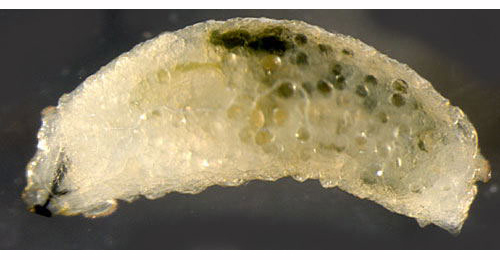 Aulagromyza hendeliana larval. lateral Image: © Willem Ellis (Bladmineerders van Europa) |
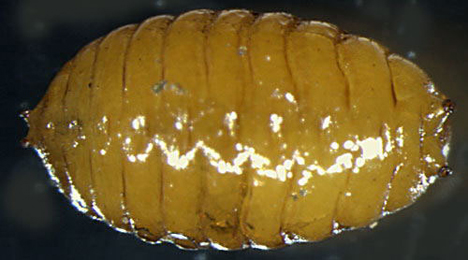 Aulagromyza hendeliana puparium Image: © Willem Ellis (Bladmineerders van Europa) |
|
Aulagromyza hendeliana (Hering, 1926) [Diptera: Agromyzidae]. |
1f > Leaf-miner: Mines similar to A. hendeliana but darker (British leafminers), filled centrally with dark-green frass (Spencer, 1976: 318). Little widening, upper-surface corridor, generally unbranched and not associated with the leaf margin. Frass in a broad green band with scattered dark granules, sometimes locally with ill-defined strikes. Pupation outside the mine; exit slit in upper epidermis. |
|
Aulagromyza luteoscutella (de Meijere, 1924) [Diptera: Agromyzidae]. |
|
Key for the identification of the known mines of British |
Note: The larvae of mining Coleoptera, Hymenoptera and Lepidoptera may live in a corridor mine, a corridor-blotch mine, a blotch mine, a case, a rolled or folded leaf, a tentiform mine or sandwiched between two more or less circular leaf sections in later instars. Larva may pupate in a silk cocoon. The larva may have six legs (although they may be reduced or absent), a head capsule and chewing mouthparts with opposable mandibles (see video of a gracillarid larva feeding). Larvae of Hymenoptera and Lepidoptera usually also have abdominal legs (see examples). Frass, if present, never in two rows. Unless feeding externally from within a case the larva usually vacates the mine by chewing an exit hole. Pupa with visible head appendages, wings and legs which lie in sheaths (see examples). |
1a > Leaf-miner and case-bearer: The larva lives outside the mine, protected by a case, and feeds on the underlying plant tissues via a hole cut in the epidermis. From that point it eats away as much leaf tissue as it can reach without fully entering the mine. Mine does not contain frass (Coleophora species) |
1b > Leaf-miner, but not a case-bearer: The larva lives mainly inside the mine. Mine usually contains frass. In later instars the larva may live sandwiched between two more or less circular sections cut from the leaf. |
2a > Leaf-miner and case-bearer: Lobe case. The full grown case is about 7 mm long. The mouth angle is 0°, causing the case to lie flat on the leaf. The case is gradually enlarged by the addition of rings that are cut out of the epidermis. The rings become gradually larger, and stick irregularly out of the contour of the case. The rings are cut out of the lower epidermis of the mine. This implies that mines may have both normal, small openings, and large ones. Compare for instance C. violacea, that cuts rings out of the upper epidermis. The larva feeds briefly initially and again after over wintering. It then aestivates until Autumn. It makes one case which it enlarges by adding pieces of excised lower epidermis. |
|
Coleophora ahenella Heinemann, 1877 [Lepidoptera: Coleophoridae]. |
2b > Leaf-miner and case-bearer: The larva feeds on a wide range of trees, shrubs and herbs, favouring Rosaceae, but not exclusively. The fully developed cased larva may be found active in October and again, after winter diapause, in April. Cases, about 6 mm, of diapausing larvae may be found through winter, fixed to a tree or fence post. The dorsal surface of the case is usually covered in leaf fragments, but they can sometimes be worn off almost smooth. The ventral surface is swollen at the middle and has a keel, which usually bends upwards at the posterior. The cases of C. ahenella (on Rhamnus, Frangula, Viburnum and Cornus) and C. potentillae (case less swollen, keel not bent up, resting position less prone) are very similar. Brownish lobe case that lies almost flat on the leaf, either on the upper or on the lower side. Case widest about the middle. Ventrally there is a distinct keel. Mouth angle 0°. Full depth mines rather large. The flaps of cuticular tissue that serve to enlarge the case are cut out of the upper epidermis. (contrary to C. ahenella and C. potentillae, that use tissue from the lower epidermis). The removal of these tissue flaps creates holes that are much larger than those that serve as the entrance to the mine. |
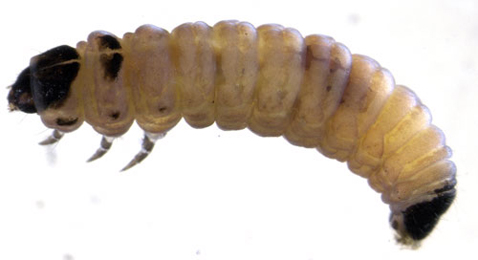 Coleophora violacea larva, lateral Image: © Willem Ellis (Bladmineerders van Europa) |
|
Coleophora violaceae (Ström 1783) [Lepidoptera: Coleophoridae]. |
3a > Leaf-miner: Full depth, somewhat inflated and puckered mine with scattered frass. Pupation outside the mine. The larva lives in the flower-buds and mines in the leaves (Belgian Lepidoptera). The larva pupates in a tough cocoon on or under the surface of the ground (Belgian Lepidoptera). |
|
Alucita hexadactyla Linnaeus, 1758 [Lepidoptera: Alucitidae]. |
3b > Leaf-miner: In the first instar the larva mines the leaves, forming short, irregular, blotch-like mines, but in later instars it lives externally, feeding in spun leaves and often twisting those of tender shoots. Larval head light-brown or yellowish brown, edged with black postero-laterally, ocellar area blackish; prothoracic plate black edged with whitish anteriorly; abdomen dull dark green; pinacula distinct, black, sometimes brownish but with black bases to setae; anal plate large, black (Bradley et al., 1973). Small, full depth mine without a definite shape; little frass. Some silk is deposited in the mine. The larva soon leaves the mine and continues feeding among spun leaves. |
|
Cnephasia incertana (Treitschke, 1835) [Lepidoptera: Tortricidae]. |
3c > Leaf-miner: Forms a large transparent blotch mine - with a central spot, where the frass collects. This spot is usually red-brown. Brownish, full depth, inflated blotch, usually at the leaf margin, often with a central brown spot. Oviposition at the leaf underside. Often 2-3 larvae in a mine. Pupation outside the mine. Pupation on the bark in a cocoon. |
|
Perittia obscurepunctella (Stainton, 1848) [Lepidoptera: Elachistidae]. |
3d > Leaf-miner: The mine is large, occupying most of leaf. The lower epidermis with several strong creases. Lower-surface, white, inflated tentiform mine, that may occupy the entire leaf. The mine causes the leaf to roll lengthwise (the folds in the lower epidermis run from leaf base to tip). Pupa in a tough, papery cocoon; in fresh mines its colour is olive green, later it changes into pale brown. |
|
Phyllonorycter emberizaepenella (Bouché, 1834) [Lepidoptera: Gracillariidae]. |
3e > Leaf-miner: The mine is usually underside, often twisting leaf into a cone. The mines can be quite abundant where it is found. Lower surface tentiform mine between leaf margin and midrib; the mine contracts diagonally, causing the leaf to roll transversely or into a pepper box. |
|
Phyllonorycter trifasciella (Haworth, 1828) [Lepidoptera: Gracillariidae]. |
| Last updated 05-Jul-2019 Brian Pitkin | ||
